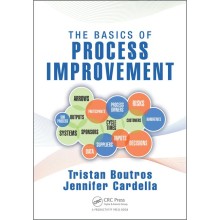What's Your Problem? Identifying and Solving the Five Types of Process Problems
ISBN: 9781466552692
Author: Kicab Castaneda-Mendez
Dispatch Time: 15 - 30 Days
Quantity:
-
Add to Compare
Typically, root cause analysis is taught by explaining a variety of tools that require users to gain considerable experience before being able to apply them correctly in the proper settings. What's Your Problem? Identifying and Solving the Five Types of Process Problemssimplifies process problem solving andoutlines specific techniques to help you identify the various types of process problems and solve them effectively and efficiently.
Arguing that there are only five types of process problems, the book explains that the Six Sigma methodology—define, measure, analyze, improve, control (DMAIC)—can be vastly simplified for learning, applying, teaching, and mentoring. It identifies the five types of process problems and describes how to solve them using a three-step procedure:
- Identify the type of problem
- Find the root cause
- Address the root cause
Describing how to maximize ROI for Lean Six Sigma initiatives, the book:
- Facilitates the application of Lean and Six Sigma principles to both self-learning and teaching others process improvement
- Presents time-tested methods to help you reduce start-to-finish improvement/project times
- Identifies techniques that can shorten the time it takes to complete projects, reduce documentation of projects, and increase overall understanding of your projects
Outlining proven approaches for seamlessly integrating Lean and Six Sigma methodologies with learning and teaching process improvement, the book will help to improve your courses so that participants acquire essential skills quicker and at lower costs. For the self-initiated, this book will get you identifying and solving the two most common process problems within hours, rather than days or weeks.
Preface
Part I : Single Unit Process Improvement
Chapter 1 : Delay-Caused Defect
Chapter 2 : Error-Caused Defect
Chapter 3 : Suboptimality-Caused Defect
Chapter 4 : Unpredictability-Caused Defect
Chapter 5 : Personal Reason-Caused Defect
Part II : Multiple Unit Process Improvement
Chapter 6 : How Do I Know I Have a Process Performance Problem?
Chapter 7 : How to Know the Root Cause
Chapter 8 : How Does the Proposed Solution Work?
Chapter 9 : How to Know When to Improve Again
Chapter 10 : Designing Processes
Part III : Teaching Problem Solving
Chapter 11 : Three-Step Procedure Lessons
Chapter 12 : Critical Thinking Lessons
Index
Write a review
Your Name:Your Review: Note: HTML is not translated!
Rating: Bad Good
Enter the code in the box below:
Copyright © 2014 Engineering Standards Bureau. All Rights Reserved.
Developed By Zoom Into Web







